

Follow these simple instructions for laying resilient floor tile of any type. Completely read all instructions before starting the job. If any part is unclear, call or visit the store where you purchased the materials and ask for further information.
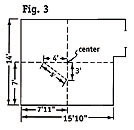 |

START FROM THE EXACT CENTER OF THE ROOM
The first run of floor tile should be started from the exact center of the floor, so use these steps to locate the center of the room:
- Locate the exact center on each wall and mark that center spot.
- In rooms with offsets or irregularities, ignore the irregularities in the measuring process (see Fig. 3).
- Hold a chalk line at the center position on facing walls, as marked and snap it on the floor. The exact center will be marked at the point where the two lines cross. The example in Fig. 3 shows a room 15'10" by 14' with a slight offset.
- To check for accuracy, measure 3' in one direction and 4' in the opposite (90°) direction. When measured from true center, the distance from the 3' marking to the 4' point will be exactly 5'. If this is not the case, remeasure and rechalk each wall to find the true center. This is essential for a quality finish.
|
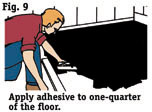
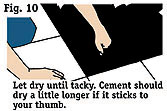 |
 APPLY THE TILE CEMENT
APPLY THE TILE CEMENT
The next step - now that you have correctly marked the center of the room and selected the tile designs and patterns - is applying the adhesive for the tile. If you are using self-sticking tile, skip this section.
- Read all instructions for the product and follow carefully. Begin by spreading an even coat of adhesive over one-fourth of the floor. Most adhesives are applied with a notched trowel (see Fig. 9), but some are still applied with a brush or roller.
- In most cases, floor tile cement will dry to the proper consistency in about 15 minutes. However, your exact time may vary depending on humidity, temperature, etc., in the room where you are applying the tile.
- After about 15 minutes, place your thumb onto the cement (see Fig. 10). The cement should feel tacky but should not actually stick to your thumb. If it does stick, allow a little longer for proper drying.
- When tacky but not sticky, the cement is ready for the application.
|
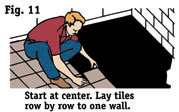

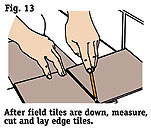
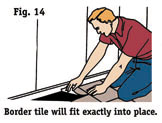
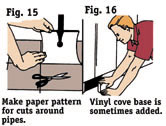 |
 LAY THE FLOOR TILES
LAY THE FLOOR TILES
- Start laying the tile at your markings in the center of the floor. It is important that the first tile is exactly square with the lines. If the first tile is started wrong, all other tiles will also line up incorrectly.
- Be sure each tile is butted firmly against the previous one, leaving no gaps.
- Do not attempt to slide tiles into place. Lay each tile firmly into position on the cement.
- Proceed by laying tiles alternately, according to your plan, toward each wall as illustrated in Fig. 12. This helps to counteract expansion and contraction of the tiles while enhancing the appearance
- To cut the border tile easily and accurately, place a loose tile squarely over the last field tile in the row (see Fig. 13). Then take another tile, butt it against the wall and mark, as illustrated. Cut the tile along the marked line using ordinary scissors. In a cold room, you should warm tiles slightly before cutting.
- The cut tile will now fit securely into the border space. Be sure this tile is placed face-up and at right angles to the grain of the tile below it. This ensures the correct pattern when it is laid (see Fig. 14).
- When it becomes necessary to fit tiles around pipes or other obstructions, simply cut a paper pattern that fits around such obstructions and trace the pattern on the tiles. Then cut with ordinary scissors (see Fig. 15) and place around obstruction.
- You may want to consider adding a vinyl cove base of matching or contrasting color (see Fig. 16) to add to the appearance and to make the floor easier to clean.
IMPORTANT NOTE
Do not wash your new tile floor for at least one week after installation.
|
TOOL AND MATERIAL CHECKLIST
| Chalk | Chalk Line | Mastic | Mastic Trowel |
| Plane | Cement | Sandpaper | Steel Square |
| Ordinary Scissors | Brush | Level | Scraper |
| Tape or Folding Rule | Hand Cleaner |
Check your state and local codes before starting any project. Follow all safety precautions. Information in this on-line brochure has been furnished by the National Retail Hardware Association. Every effort has been made to ensure accuracy and safety. Neither the NRHA nor the retailer can be held responsible for damages or injuries resulting from the use of the information in this document.
Ask for Other "Show-How" Instruction Sheets
Additional easy-to-use instruction sheets for home do-it-yourself projects are available from you local supplier of materials. Come in and ask for "Show-How" instructions when you get ready for that next handyman project!
|
See What's

Need a Contractor?
Find One Fast
Need Supplies?
Shopping
Directory

Blow out flooring - SAVE up to 70%
|

